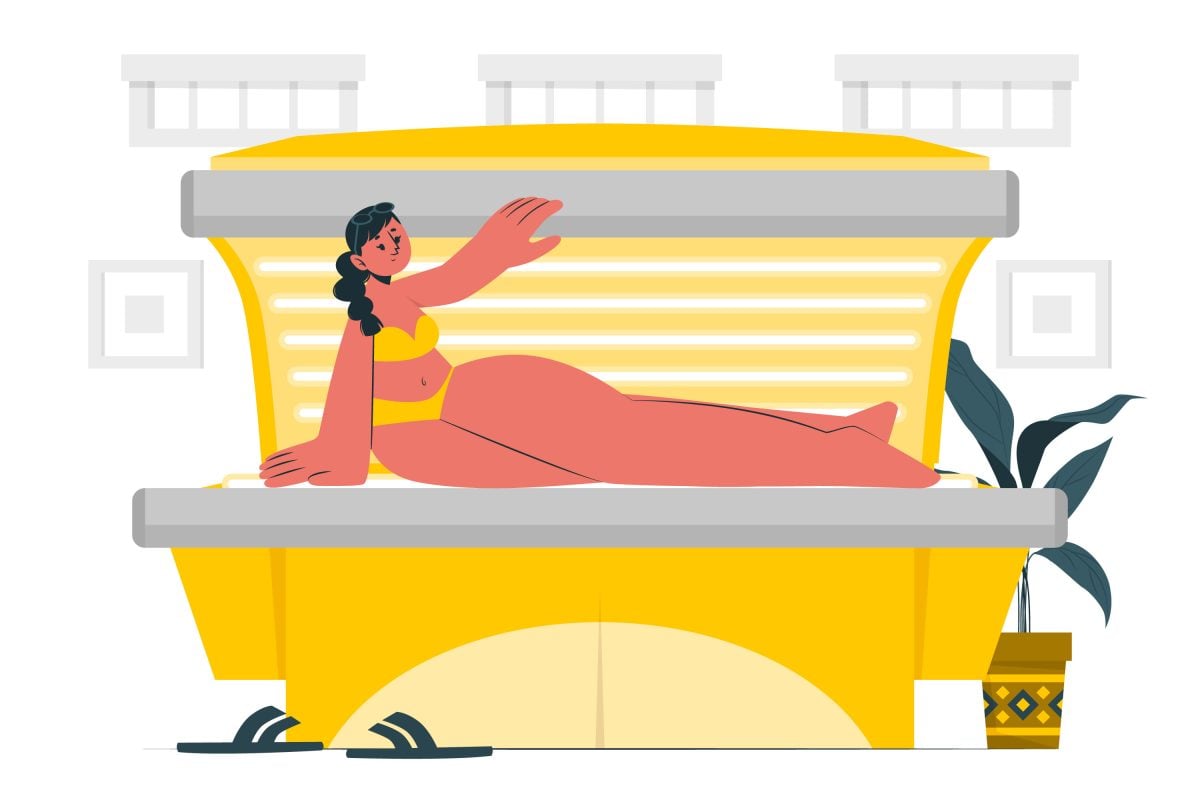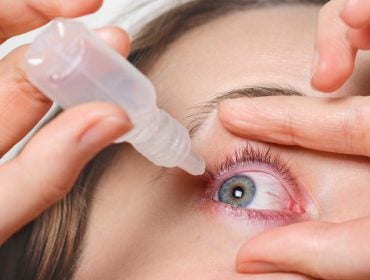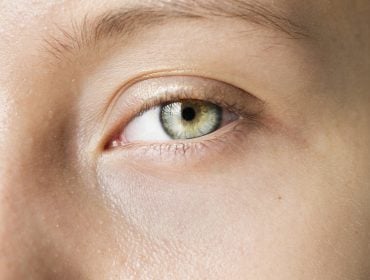Do tanning beds trigger herpes outbreaks?
On a sun-kissed beach vacation, Emily noticed her cold sores reappearing shortly after seeking a golden tan in a tanning bed, a connection that, while seemingly coincidental, is scientifically grounded.
Ultraviolet light, the culprit behind such flare-ups, is abundant in tanning beds.
It is well-documented that exposure to ultraviolet (UV) radiation can provoke reactivation of herpes simplex virus, with both HSV-1 and HSV-2 being susceptible.
Tanning Beds vs. Natural Sunlight: Outbreak Risks Compared
Tanning beds concentrate ultraviolet (UV) exposure, this extreme exposure possibly heightening herpes outbreak risks.
In natural sunlight, UV intensity is regulated by time of day and atmospheric conditions, offering some variability in exposure. Conversely, tanning beds provide a consistent and controlled source of UV radiation, which can be more intense than natural sunlight at its peak.
This controlled environment lacks the protective factors found naturally outdoors, such as shade and intermittent cloud cover, which can reduce continuous UV impact. Though both forms of UV exposure can trigger herpes virus activation, the intensity and predictability of tanning beds may lead to more consistent activation patterns.
In summary, while natural sunlight offers fluctuating UV levels, tanning beds present a stable, high-intensity UV environment, potentially increasing outbreak frequency for herpes.
HSV Specificity: Who Gets Affected
Herpes Simplex Virus (HSV) exists predominantly in two forms: HSV-1, often associated with oral herpes, and HSV-2, which usually causes genital herpes. Both variants of the virus can be affected by ultraviolet (UV) radiation, and thus, individuals with either strain are susceptible to outbreaks that may be induced by tanning bed use. Regardless of the site of infection, whether oral or genital, the inherent photosensitivity of these viruses to UV light remains a considerable risk factor for the reactivation of dormant viral particles.
Individuals with a history of either HSV-1 or HSV-2 infections should be cautious when utilizing tanning beds, as these devices emit concentrated UV light that can precipitate outbreaks. The propensity for inducing herpes simplex reactivation is not limited to a particular strain, therefore, precautions are necessary for individuals with either type to mitigate the risk and manage the potential for flare-ups effectively.
HSV-1 and Sun-Induced Flare-Ups: Common Links
Exposure to ultraviolet (UV) light is a well-documented trigger for HSV-1 outbreaks.
- UV Radiation: Ultraviolet light exacerbates HSV-1 by compromising the skin’s integrity, allowing viruses to reactivate.
- Immunosuppression: UV exposure can lead to localized immunosuppression, reducing the skin’s ability to suppress the herpes virus.
- Stress Response: Skin cells emit stress signals upon UV exposure, which may activate the HSV-1 virus.
- Heat: Increased temperatures from sun exposure or tanning beds may also contribute to viral reactivation.
Avoid intense UV exposure to prevent the reactivation of HSV-1.
Regular application of sunscreen and seeking shade are viable preventive strategies.
Unveiling the Trigger: UV Light and Herpes
Ultraviolet (UV) light, particularly UV-B radiation, has been identified as a potent stimulant in the reactivation of the herpes simplex virus. This incitement of viral replication and subsequent lesion manifestation can occur under the influence of intense UV exposure, as found in tanning bed environments. Both HSV-1, primarily responsible for orolabial herpes, and HSV-2, typically associated with genital herpes, are responsive to this trigger. The immunosuppressive effects of UV light can compromise the skin’s integrity and defense mechanisms, thereby facilitating viral resurgence. Consequently, individuals with a history of herpes infections may experience more frequent recurrences following UV exposure, a pertinent consideration for those who routinely utilize tanning beds or engage extensively in outdoor activities.
Skin’s Stress Response to UV Exposure
UV radiation in tanning beds poses a significant threat to the integumentary system, the protective barrier comprised of the skin and its adjuncts. Within this protective sheath, peril lurks as UV exposure can reactivate quiescent pathogens, like the herpes simplex virus.
When skin cells absorb UV light, they may sustain molecular injury, setting off a cascade of intracellular stress responses. This process, termed the cellular stress response, inaugurates a series of defensive maneuvers within the cells. Proteins refold, DNA repairs itself, and immunogenic peptides come to the forefront. But the disturbed cellular milieu is not always conducive to containing latent viruses; it can inadvertently furnish an opportunity for the herpes simplex virus to reawaken and proliferate.
Moreover, UV-induced stress leads to the deployment of an arsenal of cytokines and chemokines, tasked with managing cellular repair and inflammation. Yet, this well-meaning inflammatory response may, paradoxically, encourage viral reactivation. The inflammatory milieu engenders an environment that disrupts the delicate balance the immune system maintains to keep latent viruses in check.
Consequently, the stress response incited by UV exposure not only perturbs cellular homeostasis but may also tilt the scales toward viral reactivation. While the skin endeavors to repair UV-induced damage, it may unintentionally awaken latent viral elements. This reactivation can be compared to lifting the needle on a record player only to accidentally nudge it into playing an unwanted tune—here, the tune being symptomatic herpes outbreaks, a discordant note against the body’s symphonic efforts to maintain well-being.
Immune Defense Compromised by UV Light
Prolonged exposure to UV light, a ubiquitous component of tanning bed radiation, is known to have deleterious effects on the body’s immune response. Such exposure attenuates the function of Langerhans cells, the skin’s vanguard of immune surveillance, rendering them less effective in their role as sentinels against viral infections. When these cells falter, dormant viruses like herpes simplex are afforded an opportunity to resurge.
The integrity of the human immune system is critically undermined by UV radiation, not only impairing local defense mechanisms but also systemic immunity. As UV radiation depletes antigen-presenting cells and impairs lymphocyte function, the protective barrier against latent herpes virus weakens, setting the stage for potential outbreak.
Tanning-Induced Immunosuppression Mechanics
Ultraviolet (UV) radiation from tanning beds can precipitate a cascade of immunological events, leading to reduced immune competence.
- Disruption of Skin Barrier Function: UV light compromises the skin’s protective role.
- Reduction of Langerhans Cells: These immune sentinels become less vigilant under UV assault.
- Impaired Cytokine Release: Signaling molecules essential for immune responses are adversely affected.
- Lymphocyte Function Deterioration: A crucial component of the adaptive immune system operates sub-optimally.
- DNA Damage in Skin Cells: UV-induced genetic mutations hamper the immune response.
With a compromised immune system, the body’s surveillance against pathogens is lowered, enhancing the risk for herpes viral reactivation.
Looming beyond immediate burns or temporary pigmentation, the UV-induced suppression of immunity poses a latent threat to the equilibrium of the body’s defense system.
Heat: A Hidden Culprit in Herpes Flare-Ups
Warm conditions generated by tanning beds are known to foster environments conducive to the activation of herpes simplex viruses. The thermal stress imposed upon the skin while using tanning beds can destabilize dermal homeostasis, potentially igniting a viral awakening. Specifically, this is due to the heat intensifying metabolic activity that strains cellular functions, creating circumstances amenable to herpes simplex replication and subsequent outbreak.
The experience of a controlled climate, typically associated with tanning bed sessions, leads to increased skin temperature—a factor that can exacerbate herpes simplex symptoms. Dermal heat stress may provoke viral proteins and nucleic acids to emerge from dormancy, culminating in the presentation of the characteristic herpes lesions on the body’s surface.
The Heat-Herpes Connection
Elevated temperatures influence various physiological processes in the human body that are essential for maintaining equilibrium, or homeostasis.
In the context of a tanning bed’s heat, this thermal elevation extends beyond comfort, impacting cellular stress and the immune system’s prowess, potentially challenging viral suppression mechanisms.
Temperature hikes within the epidermal layers can also modify the skin’s local immune surveillance, rendering it less effective in restraining herpes simplex virus activation and proliferation.
The dynamics of heat as it interacts with the skin’s cellular structure may expedite the herpes virus’s reactivation cycle from latency to active replication, facilitating the emergence of symptoms.
Accordingly, those with herpes simplex should remain vigilant about the contributory role of heat from tanning beds in the risk of outbreak initiation.
Proactive Measures for UV Lovers
Frequent users of tanning beds might consider reducing their sessions to diminish the risk of herpes outbreaks. If abstinence is not an option, timing visits for shorter, less intense periods can lower the likelihood of viral reactivation. Even wearing underwear or lip balm with SPF could help.
For those who are avid sun-seekers, incorporating a broad-spectrum sunscreen with a high SPF, reapplying it according to its instructions, and sporting protective clothing are essential steps. Additionally, the use of lip balm that contains SPF can safeguard against HSV-1 flare-ups, commonly associated with cold sores.
Utilizing antiviral medications prophylactically, as prescribed by a healthcare provider, can offer another layer of defense for individuals prone to recurrent episodes. This strategy is particularly pertinent for those who cannot avoid regular exposure to UV radiation.
Tanning Bed Alternatives to Lower Outbreak Risks
- Spray tanning: Opt for spray tans as a safe alternative to achieve your desired bronze without UV exposure.
- Self-tanning creams: These are readily available and can impart a natural-looking tan without risking herpes activation.
- professional airbrush tanning: This services apply color directly to the skin, avoiding ultraviolet light triggers.
Consult with dermatologists who may recommend topically applied bronzers that provide a temporary glow while preserving skin integrity. Embrace your natural skin tone and focus on skincare routines that enhance your overall complexion and health.
Protective Practices for Outdoor Enthusiasts
Allow limited sun exposure during peak UV hours.
Implementing strategies for moderation and protection is essential. When outdoors, seek shade periodically, especially during times when the ultraviolet radiation is the most intense, typically from 10 a.m. to 4 p.m. Additionally, wearing protective clothing such as long sleeves and wide-brimmed hats helps prevent excessive UV exposure.
Choose UV-blocking lip balm.
High-SPF sunscreen is a staple of skin health – equally important is lip protection. Lips are susceptible to UV damage and, thus, to herpes outbreaks. Therefore, using lip balm with sunblock can be a significant preventative measure against flare-ups.
Stay hydrated and boost your immune system.
Maintaining overall health can affect your body’s response to virus activation. Consume a nutritious diet, stay hydrated, and consider supplements to bolster your immune defenses. These lifestyle choices can mitigate the risk of an outbreak.
Keep stress levels in check.
Chronic stress can weaken the immune system, increasing vulnerability to viral activations. Engage in stress-reduction techniques such as meditation, exercise, and hobbies. These practices can promote resilience not just against herpes recurrence but for overall well-being.
Managing Herpes: From Symptoms to Prevention
Recognizing the link between ultraviolet (UV) exposure and herpes outbreaks is essential for both prevention and the effective management of herpes simplex virus (HSV). While UV radiation can provoke the reactivation of herpes lesions, comprehensive preventive strategies can minimize these effects. Both HSV-1, typically responsible for oral herpes, and HSV-2, which usually causes genital herpes, can be influenced by UV light; however, individual responses vary depending on one’s immune system and the virus latent state.
Individuals who frequently utilize tanning beds or are regularly outdoors must adopt diligent protective measures to inhibit herpes flare-ups. This includes the application of high-SPF sunscreen to shield all exposed skin and using UV-blocking accessories. Moreover, when considering using tanning beds, moderation is critical, and it might be beneficial to seek out alternatives that do not emit UV rays. By cultivating a robust immune system through a healthful lifestyle and reducing UV exposure, one can potentially lessen the frequency and severity of herpes outbreaks.
Recognizing Early Signs of an Outbreak
Early detection is paramount for mitigating the impact of a potential herpes outbreak.
- Prodromal symptoms such as itching, tingling, or burning sensations
- Slight swelling or redness in the affected area
- Unusual skin sensitivity or pain around the area
- The appearance of small, painful blisters, which may be filled with fluid
These signs often precede the full development of lesions by hours or days.
Strategies to Mitigate Recurrence Risks
Avoiding overexposure to sunlight is pivotal in preventing herpes flare-ups. Implementing a regular skincare regimen that includes sunblock can drastically reduce UV-induced episodes. For tanning enthusiasts, exploring spray tans or bronzing lotions as substitutes for UV tanning beds is advisable. Discussing prophylactic antiviral therapy with a healthcare provider may be beneficial for those frequently exposed to sunlight. When outdoors, wearing protective clothing and seeking shade during peak UV hours can help mitigate risks.
If you think you might have been exposed to herpes I or herpes II and want to be sure before you start tanning for your next vacation order an online herpes test from STDCheck to start prompt treatment and preventative measures.
Medically Reviewed by J. Frank Martin JR., MD on March 19, 2024
Secure and Confidential
STD testing services
The fastest results possbile - available in 1 to 2 days

Tagged
Categorized As
Author: STD Check Editorial Team
At STDCheck.com, we go to great lengths to ensure quality content. We’re using our own collection of data. It is not bought or made up for “click-bait” purposes. We don’t entice traffic with cheesy graphics or raunchy headlines. Our information is to promote STD testing, educate people, let go of social stigmas, and bring awareness. We also provide a completely confidential atmosphere through private testing. When we produce an article, it is fact-based. We check it with medical advisors that approve it. Our staff consists of doctors and other medical professionals who peer review the content we make available on STDCheck.com. From all over the world, we have sourced the best and the brightest content developers, including medical professionals, marketing engineers, data scientists, content specialists, and media relations.




